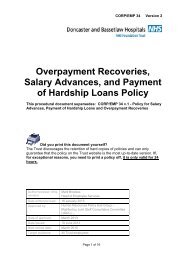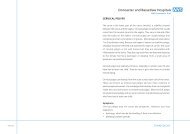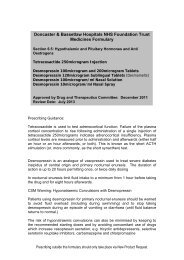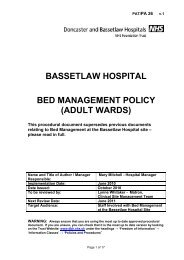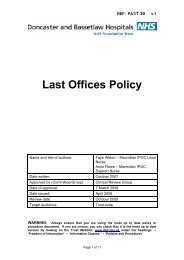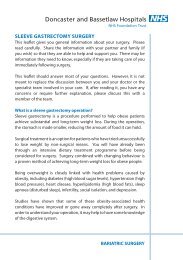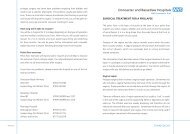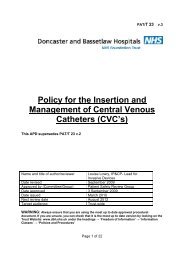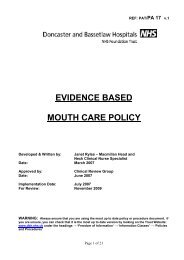acute neck sprain and whiplash injuries - Doncaster and Bassetlaw ...
acute neck sprain and whiplash injuries - Doncaster and Bassetlaw ...
acute neck sprain and whiplash injuries - Doncaster and Bassetlaw ...
Create successful ePaper yourself
Turn your PDF publications into a flip-book with our unique Google optimized e-Paper software.
Heat <strong>and</strong> cold<br />
The use of hot <strong>and</strong> cold applied locally to the <strong>neck</strong> can provide some<br />
short term pain relief <strong>and</strong> help relax muscle spasm.<br />
Cold application is most effective for the first few days after injury. Wrap<br />
a bag of frozen peas in a damp teatowel <strong>and</strong> apply across the back of<br />
your <strong>neck</strong> <strong>and</strong> shoulders for about 5-10 minutes <strong>and</strong> repeat 3-4 times<br />
during the day.<br />
Heat is usually most effective after the first three days. Using a hot water<br />
bottle wrapped in a towel, or a wheat bag, apply for 15-20 minutes <strong>and</strong><br />
repeat as necessary throughout the day.<br />
Posture<br />
Poor posture can delay your recovery <strong>and</strong> it is important to avoid<br />
slouching <strong>and</strong> sitting with your chin poking forward. Try to sit up straight<br />
with a hollow in your lower back. Use a rolled-up towel placed at the level<br />
of your waistb<strong>and</strong> to help to maintain this position. Keep your shoulders<br />
pulled back <strong>and</strong> relaxed.<br />
PHYSIOTHERAPY<br />
Avoiding staying in one position for<br />
long periods, eg sitting or driving.<br />
Change your position regularly to help<br />
you avoid adopting poor postures <strong>and</strong><br />
avoid prolonged periods of inactivity.<br />
Sleeping<br />
Try to sleep with your head in line<br />
with the rest of your body; avoid over-<br />
bending or twisting at the <strong>neck</strong>. You<br />
may need to adjust the number of<br />
pillows that you use to allow this. One<br />
is usually adequate when lying on your back, but two may be better if<br />
you sleep on your side.<br />
A small rolled-up towel placed in the crook of your <strong>neck</strong> will help to fill<br />
the gap between your <strong>neck</strong> <strong>and</strong> shoulders <strong>and</strong> support your <strong>neck</strong>. You<br />
may also find it helpful in the initial days following your injury that, while<br />
changing position in bed, you use your h<strong>and</strong>s to support the weight of<br />
your head.



